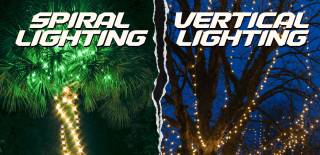Are you aiming to sprinkle magic in your backyard for those special times? Or do you wish to boost the charm of your outdoor area throughout the year? Either way, we're here for you. We'll guide you through choosing the perfect lights and give you handy tips on setting them up. Our goal is to help you wrap your lights safely and efficiently. Let's get started.
Understanding the Basics of Tree Lighting
Tree lighting is more than just an aesthetic choice; it's a form of art that requires understanding the unique structure of each tree, the type of lights that best complement it, and the techniques to safely and effectively wrap the trees. The goal is to illuminate your trees in a way that highlights their natural beauty, provides functional lighting for your outdoor spaces, and creates a welcoming atmosphere for family and guests alike.
Choosing the Right Lights
Before diving into the wrapping techniques, selecting the appropriate lights for your trees is crucial. LED lights are often preferred for their energy efficiency, longevity, and the fact that they remain cool to the touch, reducing the risk of tree damage. Consider the lights' color, size, and spacing based on the desired effect and the type of tree you are decorating. Warm white lights are ideal for a classic, timeless look, while colored lights can add a fun, festive flair.
Selecting the Right Tree
Selecting the right tree is the first step in illuminating your outdoor space with tree lights. Not all trees are suitable for wrapping, and your choice can significantly impact the final display. Look for trees with exciting forms, sturdy branches, and good health. Evergreens, maples, and extensive ornamental trees often provide excellent canvases for lights due to their dense foliage and intricate branch structures. Avoid trees with weak branches or those that are sick, as the added weight and stress of the lights could cause damage.
Tree-Wrapping Techniques
Once you've selected the perfect tree, it's time to consider the wrapping techniques. The two most popular methods are the spiral wrap and vertical strands, each offering a unique visual effect.
- Spiral Wrap: This technique involves wrapping the lights around the tree in a helix pattern, starting from the bottom and working your way up. It's ideal for highlighting the tree's shape and creating a dynamic, swirling effect. The spacing between each wrap can be adjusted based on the desired density of the lights.
- Vertical Strands: Vertical strands are an excellent choice for a more uniform and elegant look. This method involves hanging strands of lights vertically from the top of the tree to the bottom, ensuring that each strand is evenly spaced. It's particularly effective on taller trees, emphasizing their height and structure.

Safety Precautions
Safety should always be your top priority when wrapping trees with lights. Follow these precautions to ensure a safe and enjoyable lighting experience:
- Use lights that are rated for outdoor use to avoid electrical hazards.
- Inspect all light strands for frayed wires or broken bulbs before installation.
- Avoid overloading electrical outlets and use a ground fault circuit interrupter (GFCI) for additional protection.
- Use a sturdy ladder and have someone spot you when wrapping higher branches.
- Do not attach lights with nails or staples; they can damage the tree's bark and create entry points for pests or diseases.
Steps For Wrapping Trees with Lights
- Plan Your Design: Decide the wrapping technique and pattern you wish to achieve. Consider the tree's shape and how the lights enhance its natural beauty.
- Prepare the Lights: Unravel the light strands and check for any damage. Plug in the lights to ensure all bulbs are working.
- Start at the Base: For the spiral wrap, begin at the tree's base and slowly work your way up, ensuring the lights are wrapped snugly but not too tight. Start from the top and secure the first strand for vertical strands before gently lowering it to the ground.
- Wrap the Branches: Depending on your design, you may also wish to wrap individual branches to add depth and texture to the lighting.
- Connect Additional Strands: If you need more length, carefully connect additional strands of lights, taking care not to overload the circuit.
- Power Up: Once all lights are in place, plug them into your power source and adjust any strands to achieve the desired effect.
- Enjoy Your Handiwork: Step back and enjoy the magical atmosphere you've created with your beautifully lit tree.
Strobert Tree Services: Leaders in Delaware Tree Care
At Strobert Tree Services, we understand the importance of maintaining the health and beauty of your trees. Serving Delaware, Pennsylvania, and New Jersey, our team of expert arborists is here to provide top-notch tree care services, from pruning and maintenance to emergency tree removal. If you're planning to wrap your trees with lights but are unsure of the condition of your trees or need professional advice, feel free to reach out to us.











